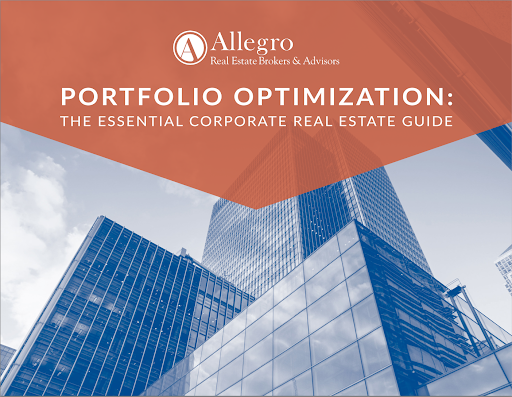There is no doubt that law firms are changing the way they handle their real estate.
While office spaces are still paramount for firms, hybrid work has transformed the way those spaces are designed and used by executives and employees alike. Those changes are here to stay.
Many of the common uses of law firm offices still remain, such as hosting client meetings or providing a place for employees to work. However, law firm office design has changed to reflect a greater sense of collaboration and embrace a more tech-influenced landscape.
Choosing the right real estate options for your law firm is critical for attracting and retaining top talent—and driving overall success.
To help law firms meet business goals, keep employees happy, and get the most out of their real estate, this guide will cover the following:
- An overview of law firm commercial real estate.
- The history and evolution of law firm real estate.
- Factors to consider in law firm office spaces.
- 6 top trends in law firm real estate.
- The commercial real estate process for law firms.
- The benefits of working with an experienced law firms commercial real estate broker.
An Overview of Law Firm Commercial Real Estate
Like many other professional services firms, law firms use their office spaces for attorneys to complete work, to host clients, and to conduct internal meetings. As a result of this need for private spaces, many law firm offices have historically been built out to incorporate a plethora of large, individual office spaces and meeting rooms.
While trends were shifting, the COVID-19 pandemic accelerated the movement to new ways some law firms use real estate.
Now, many law firms have embraced a more efficient office model, one that encourages collaboration while still upholding the office’s main purpose as a designated meeting space. While this change comes as a result of hybrid work schedules and increasing technology adoption, it does not diminish the need for law firm office spaces. Law firms continue to value their real estate as a way to conduct professional, successful business.
The History and Evolution of Law Firm Real Estate
Historically, law firms allocated about 1,000 square feet per attorney. This generally included an office large enough to fit tables and couches to host internal meetings, as well as supportive spaces like administrator and support staff work areas, and communal spaces. Because each attorney had their own space, the majority of the real estate was put toward private, individual offices.
Now, because attorneys have less support staff, fewer internal meetings are taking place in the attorney’s individual offices and there is a push for efficient use of space. Today, attorneys are being allocated approximately 600 to 700 square feet of space each. Universal office sizes, where partners and associates have equal space, is also becoming more common.
Law firm real estate sizes are now changing, too, as firms decrease their footprints for more efficient spaces—a trend that’s been accelerated by the pandemic. Meeting spaces are being consolidated, and many offices now have one common conference facility—versus rooms spread throughout the entire space—lending the remaining available space for collaboration and shared areas. Now digitized, law libraries and file storage also require less space than in the past.
Factors to Consider in Law Firm Office Spaces
There’s no set rule for how to determine law firm real estate, which can make it difficult for firms to know if they’re making the right real estate decisions. Some embrace a more traditional office setup, while others have either moved or upgraded their spaces to reflect a more collaborative way of working. Company culture, budget, and employee preferences are a few factors that can play a significant role in whether a firm chooses a traditional or hybrid office setup.
Traditional vs. Hybrid Office Space
In a traditional law firm office space, most members of staff have their own individual offices with few shared spaces. Most of these areas are closed off so attorneys can shut their doors for private meetings or work without distractions. The majority of the attorney offices in a traditional design are located around the perimeter of the space, facing windows with administrator and support staff on the interior.
While many law firms still embrace a traditional office space setting, some have shifted their mindsets to focus on smaller spaces for a hybrid law firm office. These spaces feature open offices and shared areas for improved collaboration and communication. Hybrid layouts still feature some private rooms and conference spaces for confidential conversations.
Pros and Cons of an Alternative Office Layout
While some law firms have been moving towards non-traditional office layouts, it’s important to weigh the pros and cons of this change before making a decision. Alternative layouts may include reducing office space, adding collaborative spaces, or moving to a hoteling model where select hybrid attorneys share the same office on separate days. These layouts have the potential to reduce costs and create a more flexible working environment.
However, non-traditional office layouts can also be significantly noisier, leading to distracted employees and lower productivity. In addition, with the sanctity of the attorney-client privilege, attorneys must still have confidential phone calls and client meetings in one of the limited private spaces available.
Office Locations
Location is also key when considering law firm real estate. To be easily accessible, law firms typically choose spaces in downtown areas or central locations near primary businesses. Many, however, have begun exploring satellite offices so they can be close to all of their clients, rather than only the ones near their headquarters.
In addition, some law firms choose to move their back office operations (think: marketing and finance departments) out of their Class A downtown headquarters and into a more affordable market or sub-market. This is an easy way for law firms to cut costs without sacrificing the quality of their public-facing real estate.
Budget
Law firms also generally sign longer office leases, which is why it can be difficult for them to move locations. Plus, the longer the lease, the more landlords will offer in tenant improvement (TI) allowances. Many law firms take this factor into consideration when deciding to renovate their current spaces or move, as the TI allowance dollars spread over a longer term can help reduce the impact of the cost of an office build out.
6 Top Trends in Law Firm Real Estate
As many law firms upgrade their offices to reflect a new way of working, they’re prioritizing ways to attract and retain top talent, as well as keep their employees happy and healthy. Some of these top law firm office trends include the following:
1. Comforting Features
Law firms are offering their employees amenities they can’t get at home—but also make them feel at home. Some of these features can include high-touch concierge services, coffee baristas, green spaces, outdoor patios, conference rooms, and more. Some firms also incorporate details that promote comfort, such as cozy furniture and unique, home-like design aspects.
2. Health and Wellness Conveniences
Health and wellness also plays a critical role in law firm offices, with key amenities including fitness centers, large windows that allow for ample natural light, and healthy dining options. Law firms are prioritizing wellness by ensuring their spaces offer premier indoor air quality and newer HVAC systems.
As an example, a Cleveland-based law firm moved from a 17,000-square-foot space in an older downtown building to a 30,000-square-foot space in a newer downtown building. The new space features large windows with lakefront views, as well as a private elevator.
3. Social Amenities
Social amenities are another key consideration for law firms planning their office spaces. Because many people work from home, law firms have been incorporating positive social aspects to offer their employees an experience, rather than just an office to work in.
Some of these social amenities include gathering areas like lounges, terraces, and easy access to bars and restaurants. Others include collaboration, mentoring, and knowledge-sharing spaces.
4. Technological Advancements
With the adoption of video conferences also comes the need to integrate more advanced technology in law firm office spaces. Many law firms are tapping into cloud resources, investing in secured networks and high-speed internet, and incorporating “Zoom rooms” into their spaces for video calls.
Because technology is constantly evolving and advancing, it’s important for law firms to continuously evaluate their office tech needs to make sure they’re using products that can increase efficiency and productivity, optimize workflow, and offer enhanced services.
5. Accessibility and Proximity to Amenities
Location is also playing a role in law firm real estate decisions. Employees want to work in areas that are easily accessible—whether by foot, bike, or motor vehicle.
They also want to work in office buildings that are within walking distance to several dining, retail, fitness, and sporting options. These amenities give them a break from the office setting and allow for entertaining clients without having to travel far.
6. Free or Reduced Parking
Historically, tenants have had two options when parking at an urban office building: pay a monthly unlimited fee for parking or pay a daily rate, which can add up quickly. Most attorneys chose a monthly parking pass; however, pricing was based on working at the office five days per week.
Now, some law firm leadership teams feel that the current parking fee structure is hindering attorneys’ return to work—parking has become an unnecessary expense for employees that have adopted a hybrid work schedule.
As a result, more and more law firms are negotiating with landlords to obtain affordable, or even free, parking options as well as flexible arrangements, like parking passes for a certain number of days per month, for their employees.
The Commercial Real Estate Process for Law Firms
Finding the right office space for your law firm can be a daunting task. After all, you’re trying to find a space that makes your employees happy, is conveniently located to clients, and makes sense for your firm. Fortunately, at Allegro Real Estate Brokers & Advisors, we’re here to help, and we can guide your decision using our proven tenant representation process. Below are the five steps.
1. Project Strategy and Criteria Selection
During the first phase of the tenant representation process, the Allegro team works with you to identify key success factors and drivers for your CRE need, as well as determine critical milestones. We’ll conduct a kick-off meeting with our project team and then clarify strategic, financial and operational objectives. From there, we’ll develop the project strategy and timeline.
2. Market Research and Screening
As a part of this phase, we conduct market research to develop a short list of viable properties that meet your location and office parameters, taking into consideration any of the amenities listed above that you’d like to have in your new office space. We’ll also assess your budget and programming requirements (in concert with an architect) to ensure we’re creating a list that exclusively meets your specific needs. From there, we’ll schedule tours of the short-listed properties and provide a summary of each one, including pros and cons.
3. Decision Support
During the decision support phase of our process, we gather the data needed to provide objective expert analysis and support the decision-making process. This includes developing and managing distribution of RFPs to landlords and evaluating proposed terms; conducting qualitative analyses to evaluate and compare alternatives; performing comprehensive quantitative financial analyses; prioritizing short-list locations; and preparing for further negotiations.
4. Leveraged Negotiations
To maintain leverage, our team conducts simultaneous, competitive negotiations among alternatives. We also evaluate counteroffers, resolve critical open issues for each property, finalize key business and legal terms and conditions (in collaboration with attorneys), and finalize our objective comparison of properties.
At the end of this stage, we offer a final recommendation and letter of intent or Memorandum of Agreement for the preferred site.
5. Closing and Documentation
Lastly, we finalize all transaction documentation for the chosen property. As a part of this phase, we assist legal counsel in review and preparation of final transaction documentation. We also support public announcements and coordinate the final execution of the transaction documents.
At the end of this phase, the final executed transaction documents will be delivered along with a project binder containing key project correspondence.
The Benefits of Working With an Experienced Law Firm Commercial Real Estate Broker
Finding the right space in your budget starts with finding the right real estate partner. We, at Allegro, offer unparalleled advantages that will make your real estate experience a positive one.
Conflict-Free Tenant Representation
At Allegro, we focus exclusively on tenant representation transactions, which allows us to provide the best real estate services possible for tenants in any transaction, no matter the market.
Brokers who are exclusively tenant-focused can negotiate on your behalf to get the best terms for you, not the landlord.
Alternative Fee Structures
At Allegro, we offer fee structures, like hourly fees and/or predetermined success fees, that eliminate conflicts of interest that may be present while representing on a contingent basis. This model ensures that we’re working to get you the best deal based on your unique office needs.
Licensed Attorneys on Staff
We have licensed attorneys on staff, which guarantees the team has firsthand knowledge of the nuances of law firms. This also means that we can be supportive of legal counsel during the drafting of legal documents in-house.
Experienced and Diverse Team
Our brokers have diverse skill sets, with specializations from fInancial analysis to labor data. In addition to this, we can add value when lawyers are drafting documents like letters of intent, leases, and purchase agreements. Plus, our team is experienced in working with small, medium and large law firms, so no need is too great. We understand it’s never a “one-size-fits-all” situation and customize our services to fit your needs.







